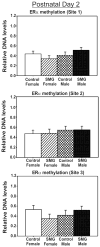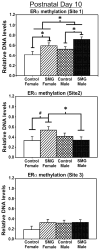Epigenetic impact of simulated maternal grooming on estrogen receptor alpha within the developing amygdala
- PMID: 21352906
- PMCID: PMC3399737
- DOI: 10.1016/j.bbi.2011.02.009
Epigenetic impact of simulated maternal grooming on estrogen receptor alpha within the developing amygdala
Abstract
Variations in maternal care alter the developmental programming of some genes by creating lasting differences in DNA methylation patterns, such as the estrogen receptor alpha (ERα) promoter region. Interestingly, mother rats preferentially lick and groom their male offspring more than females; therefore, we questioned whether the somatosensory stimuli associated with maternal grooming influences potential sex differences in DNA methylation patterns within the developing amygdala, an area important for socioemotional processing. We report a sex difference in the DNA methylation pattern of specific CpG sites of the ERα promoter region within the developing amygdala. Specifically, males have higher levels of ERα promoter methylation contrasted to females. Increasing the levels of maternal stimuli in females masculinized ERα promoter methylation patterns to male-like levels. As expected, higher levels of ERα promoter methylation were associated with lower ERα mRNA levels. These data provide further evidence that the early neonatal environment, particularly maternal care, contributes to sex differences and early programming of the neonatal brain via an epigenetic mechanism.
Copyright © 2011 Elsevier Inc. All rights reserved.
Figures





Similar articles
-
Sex differences in epigenetic regulation of the estrogen receptor-alpha promoter within the developing preoptic area.Endocrinology. 2010 May;151(5):2297-305. doi: 10.1210/en.2009-0649. Epub 2010 Mar 17. Endocrinology. 2010. PMID: 20237133 Free PMC article.
-
Maternal care associated with methylation of the estrogen receptor-alpha1b promoter and estrogen receptor-alpha expression in the medial preoptic area of female offspring.Endocrinology. 2006 Jun;147(6):2909-15. doi: 10.1210/en.2005-1119. Epub 2006 Mar 2. Endocrinology. 2006. PMID: 16513834
-
Developmental timing of the effects of maternal care on gene expression and epigenetic regulation of hormone receptor levels in female rats.Endocrinology. 2013 Nov;154(11):4340-51. doi: 10.1210/en.2013-1595. Epub 2013 Sep 3. Endocrinology. 2013. PMID: 24002038 Free PMC article.
-
Estrogen receptor-alpha gene expression in the cortex: sex differences during development and in adulthood.Horm Behav. 2011 Mar;59(3):353-7. doi: 10.1016/j.yhbeh.2010.08.004. Epub 2010 Aug 14. Horm Behav. 2011. PMID: 20713055 Free PMC article. Review.
-
Epigenetic mechanisms are involved in sexual differentiation of the brain.Rev Endocr Metab Disord. 2012 Sep;13(3):163-71. doi: 10.1007/s11154-012-9202-z. Rev Endocr Metab Disord. 2012. PMID: 22327342 Review.
Cited by
-
Sex Differences in the Epigenome: A Cause or Consequence of Sexual Differentiation of the Brain?Genes (Basel). 2019 Jun 7;10(6):432. doi: 10.3390/genes10060432. Genes (Basel). 2019. PMID: 31181654 Free PMC article. Review.
-
Sexes on the brain: Sex as multiple biological variables in the neuronal control of feeding.Biochim Biophys Acta Mol Basis Dis. 2020 Oct 1;1866(10):165840. doi: 10.1016/j.bbadis.2020.165840. Epub 2020 May 16. Biochim Biophys Acta Mol Basis Dis. 2020. PMID: 32428559 Free PMC article. Review.
-
Maternal low protein diet and fetal programming of lean type 2 diabetes.World J Diabetes. 2022 Mar 15;13(3):185-202. doi: 10.4239/wjd.v13.i3.185. World J Diabetes. 2022. PMID: 35432755 Free PMC article. Review.
-
Epigenetic changes in the estrogen receptor α gene promoter: implications in sociosexual behaviors.Front Neurosci. 2014 Oct 28;8:344. doi: 10.3389/fnins.2014.00344. eCollection 2014. Front Neurosci. 2014. PMID: 25389384 Free PMC article. Review.
-
Sex differences in epigenetic mechanisms may underlie risk and resilience for mental health disorders.Epigenetics. 2011 Jul;6(7):857-61. doi: 10.4161/epi.6.7.16517. Epub 2011 Jul 1. Epigenetics. 2011. PMID: 21617370 Free PMC article.
References
-
- Amateau SK, Alt JJ, Stamps CL, McCarthy MM. Brain estradiol content in newborn rats: sex differences, regional heterogeneity, and possible de novo synthesis by the female telencephalon. Endocrinology. 2004;145:2906–2917. - PubMed
-
- Barclay JL, Nelson CN, Ishikawa M, Murray LA, Kerr LM, McPhee TR, Powell EE, Waters MJ. GH-dependent STAT5 signaling plays an important role in hepatic lipid metabolism. Endocrinology. 2011;152:181–192. - PubMed
-
- Bonefeld BE, Elfving B, Wegener G. Reference genes for normalization: a study of rat brain tissue. Synapse. 2008;62:302–309. - PubMed
Publication types
MeSH terms
Substances
Grants and funding
LinkOut - more resources
Full Text Sources
Research Materials

